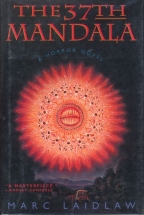|
|
|
The 37th MandalaMarc LaidlawSaint Martin's PressUS Hardcover FirstISBN 0-312-13021-XPublication Date: 02-01-1996352 pages; $23.95Date Reviewed: 07-01-02Reviewed by Rick Kleffel © 2002 |
|
|
REFERENCES |
COLUMNS |
Horror writers love to take on so-called 'New Age' thinking. It's a pretty easy target. One needs only to turn all the happy supernatural upside down and you practically have a horror novel without a great deal of effort. In doing so, however, your horrors have no more heft than the happy-wappiness of your satiric target. Phil Rickman, in his novel 'Crybbe' (published in the US as 'Curfew') did an excellent job of grounding his New Age thinkers so that they seemed enough on the ball to make the inversion of their beliefs genuinely frightening. Mark Laidlaw uses a number of Lovecraftian staples in 'The 37th Mandala' -- from false texts to multi-tentacled monstrosities -- to add veracity and grit to his often satiric take on New Age religions. It's an interesting and effective tactic. If you like your New Age skewered with a bit of ethereal calamari, 'The 37th Mandala' is your best bet to satisfy your appetite.
'The 37th Mandala' introduces Derek Crowe, a cynical non-believer who writes new-age pabulum for a gullible public. With his latest work, however, he is finally about to break through into the big-time. All those years of writing second-rate supernatural schlock paid off when he managed to connect with Elias Mooney, an authentic American magus. Fortunately for Crowe, Mooney died soon afterwards, and wasn't around to contradict Crowe's radical re-interpretation of 'The Mandala Rites'. Mooney wrote the journals as a warning that there is something out there which feeds on human misery, something that is better left untouched. Crowe, the cynical unbeliever, simply inverted Mooney's warning of unearthly terrors into a feel-good treatise on how to get in touch with what might be called your "outer child", the bliss-bestowing Mandalas. As he travels the country publicizing his book, he begins to suspect that perhaps Elias Mooney was not the madman Crowe thought him to be.
At his best, Laidlaw presents the reader with surreal visions of our reality intersecting with a hellish alternative. It's Lovecraftian in the best sense of the word, suggestive of vast yawning chasms that lie beneath our every step, intuiting the hopeless terror that hides behind our mundane actions. Unlike Lovecraft, however, Laidlaw puts a fair amount of effort in his characterizations, especially Derek Crowe and Elias Mooney. By making his characters come to life, he is able to breathe more life into his hellish visions. This leads to some particularly effective "dual-reality" scenes that will linger in the reader's mind long after the novel is finished.
But plotting and characters have always been a problem for the Lovecraftian authors, and Laidlaw is no exception. A low-life couple who are drawn into Crowe's world vision never quite gel, though they become quite important to the novel, and the big finale isn't as powerful as the visions that precede it. Still, getting there is a lot of fun, if you consider well-rendered visions of unreal despair fun. For those who who like their monsters to fade in from another dimension, 'The 37th Mandala' is all the fun you'll be able to handle.
